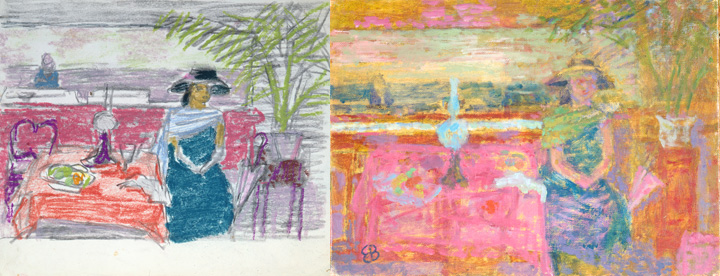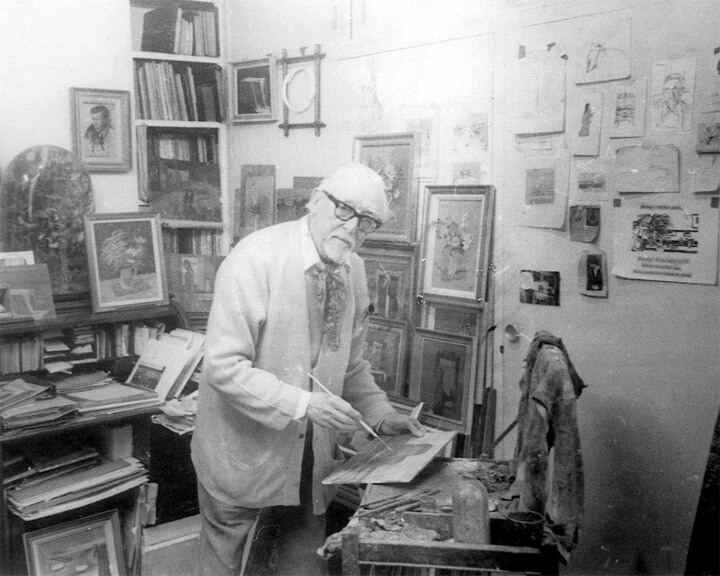The 1980's was one of the most productive decades of Edward's life in terms of the quality and number of paintings he produced. Indeed his output in the early-mid 1980's probably ranks alongside his work in the late 1940's-early 1950's and the Camden Town paintings of the early-mid 1960's as the most productive years of his life.
It was a particular feature of Edward's work that when he became intrigued by certain themes he liked to revisit the subject after the passage of time, sometimes decades, and undertake new paintings of the subject or theme. In this regard, nearly all his favourite lifetime subjects and themes are represented by major paintings done in the 1980's. These include paintings of the River Thames, Sloane Square, cafe interiors, London buildings, flower-pieces, the living room and summer balconies at East Heath Road, as well as Hampstead subjects and self-portraits. Many of the paintings completed in this decade were large works, a large number being 28 x 36 inches.
In 1980 he painted "The Red Umbrella" which is a fine example of the artist’s combined themes of café interior and self-portrait. "The Red Umbrella" is set in a café or restaurant and features a young woman waiting for her dinner partner to arrive. Before painting "The Red Umbrella", Edward undertook a series of pastel studies and smaller oil paintings on the subject to refine the idea to exactly what he wanted; examples of these are also shown inset below.

The following year Edward painted "Sloane Square, Christmas Time"(1981), which was to be his last major painting of the Sloane Square area. This painting also continues his tradition of painting major London landmarks at night and exploring the effects of urban neon light and illumination on the chosen buildings and streets, particularly after a rain-shower, a theme previously explored in "Essoldo Cinema, Chelsea"(1950), "The Princes Theatre"(1958) and "Piccadilly Circus"(1959). The rich colours of the Sloane Square Christmas illuminations emphasise both light and colour and evoke the atmosphere and enjoyment of the festive season in a winter setting.
"The Studio Club remembered"(1982) is a fond reminiscing of that Club were he spent so many pleasant evenings in the early 1950s and where he met Celeste. The atmosphere and rich crimson pallette of this painting has affinities with "The Red Umbrella" painted two years previously.
In the early 1980s Edward was continuing to produce lithographs and pen and ink drawings, particularly of flowers from Celeste’s garden at East Heath Road; "Fuchsia"(1982) was produced in a limited edition of fifty.
Edward's continuing love of painting the River Thames reached its height in this decade with "Westminster from Blackfriars"(c.1982) and two further "Star and Garter" paintings, namely "The Star and Garter, No.2"(1983), which was in the 1984 Royal Academy Summer Exhibition, and "The Star and Garter revisited"(1985). "The Star and Garter, No2" makes interesting comparison with the first "Star and Garter" painting done over thirty years previously in 1952. Before painting "The Star and Garter, No.2" he undertook a series of small oils on the subject, some of which were separately exhibited and also survive to this day.
"The English Country Teahouse"(1983) shows a solitary woman taking tea in a country teahouse. Unusually for Edward a green palette dominates the painting. "The English Country Teahouse" was exhibited at the Royal Academy Summer Exhibition in 1995.
In summer 1981 Edward painted a small oil "Celeste pulling the curtain". This painting inspired him to undertake his impressive series of five large paintings combining the themes of intimate room interior with a summer window showing a balcony of flowers in full bloom. The first two were "Summer Balcony"(1982) and "Last Summer at the Cottage"(1984), which were both exhibited at Royal Academy Summer Exhibitions, in 1982 and 1984 respectively, and also reproduced in the Illustrated Catalogues for those years.
"The Blue Parasol" is the third in this series and is based on the living room at East Heath Road and set in mid-summer with a balcony of flowers in full bloom. Like "The Red Umbrella" it also features a brightly coloured parasol. "Balcony in the Sun"(1984) is the fourth in the series and was bought by The British Petroleum Company p.l.c. from the Royal Academy Summer Exhibition in 1985. This painting, and the second "Balcony in the Sun", which was painted three years later in 1987, are both of the second bedroom at East Heath Road, looking out on to the balcony in summertime; the warm sunlight in the room and on the balcony and abundance of bright flowers capture many of the simple joys and harmonies of summer.
Edward painted a series of large oils of summer flowers in the mid -1980s. Celeste would often bring in selected summer flowers from her garden and the still life would be set-up on a table in Edward’s studio. Both "Meadowsweet in a Victorian Jug"(c. mid-1980s) and "Vase with Flowers"(1985) were painted in the studio; in both cases furniture and possessions in his studio at that time can be clearly seen in the background. "Summer Flowers"(c.mid -1980s) was another painting in this series. He also painted many smaller oils of flower-pieces during these years.
Throughout the 1980s Edward produced further work in "The Lonely Farmhouse" series; "Farmhouse near Dungeness revisited" was exhibited in Royal Academy of Arts Summer Exhibition in 1985. He also undertook a few final paintings on the Studio Club theme.
In the mid-late 1980s Edward did a series of further paintings on the self-portrait in a café theme; these included "Self portrait in a Café, No.2"(1986-1988) and "Man in a Café"(1987), which was sold at the Royal Academy Summer Exhibition in 1987 and reproduced in the Illustrated Catalogue of that year. He was continuing to record the changing nature of the Camden area and "Demolition of the Prince of Wales Crescent" was painted in 1986.
Another favoured subject revisited in the 1980’s was Edward's love of the Serpentine, which he had first painted over forty years previously. His final major Serpentine painting was "Evening by the Serpentine"(1987). It was also in 1987 that he painted his final Suffolk painting "Aldeburgh 1936", which was based on the sketches done during his first visit to the area in 1936. His lifelong friend Frank Hughes died in late 1987.
He continued to experiment with new themes and in January 1988 painted "Dancer resting".
In the 1980s he also made several more paintings of Regents Park, including "Regent's Park Bandstand in Winter"(1982) and "Regent's Park Kiosk"(1983). It was the same bandstand that was later blown up by a terrorist bomb. Edward had long admired the winter snow landscapes of Alfred Sisley and Camille Pissarro and in 1986 painted "Widford Church under snow".
By the mid-1980's Edward had been working in his studio at East Heath Road for nearly thirty years and it had evolved into a haven packed with many of his own paintings stacked in rows, sketches pinned up on the walls, work of other artists purchased over the decades, piles of art books and numerous other items of artists paraphernalia, including paintboxes, his two large easels, busts of notable people and antique clocks.

Edward, then aged 86, painting in his studio in Hampstead in 1989 (photograph taken by Bernard Dunstan, RA).
Edward continued to be active in New English Art Club affairs throughout the eighties. He became the NEAC's First Keeper in 1980. He particularly enjoyed being part of the Selection Committee selecting paintings for forthcoming NEAC exhibitions. Tom Coates' fine oil painting "Selection Committee", which was inspired by Sir William Orpen's 1909 painting "The Selecting Jury of the New English Art Club", perfectly captures the atmosphere of the NEAC's Selection Committee at that time. Members of the NEAC pictured in "Selection Committee" include Diana Armfield, Ken Howard, Bill Bowyer, Tom Coates , Edward Pullee, Mitzi McCall, Jacqui Rizvi, Bob Brown, Charlotte Halliday and Diana Calvert. Edward is pictured in the middle of the painting with his left hand raised.

Painting by Tom Coates, NEAC entitled "The Selecting Jury of the New English Art Club". Edward is pictured centre left of the painting with his left hand raised.
Occasionally Edward would also do further work on a painting well after it was first painted; "The Blue Parasol" is an example of this as he did further work on this painting in November 1985.
During this time he continued to make his own picture frames and would always draw his wife a special card for her birthday each 1st November, a wedding anniversary card in May and produce a family Christmas card, usually a linocut.
Edward retained his love of poetry and would often quote his favourite poems and sayings he had memorised many years previously. He would sometimes quote the line "If only we were young and foolish again", which was a particular favourite.
In September 1988 Lintas hosted an Exhibition in London at Agnews, which was a retrospective of selected work of some of the artists who had worked at Lintas between 1930 and 1950. It was entitled "Beyond the Horizon" and included works by Ivor Cooper, John Passmore, Keith Vaughan and Reg Jenkins. Edward's five exhibits, included "The Dispossessed : Tramps in Shelter"(1942) and "Still Life with Lupins"(1938), as well as the small woodcut "So they took a studio in Chelsea"(1930).
In 1989 fellow artist and friend Bernard Dunstan R.A. did a series of pastels and paintings of Edward and Celeste in the living room at East Heath Road. One of these fine works was reproduced on the Invitation card for the New English Art Club’s Annual Exhibition in 1989.

Oil painting by Bernard Dunstan, RA of Edward and Celeste in their living room in Hampstead in 1989.
Well into his late eighties Edward would take daily walks on Hampstead Heath near his home, particularly enjoying the stroll to the Vale of Health and the ponds; he had become a familiar and distinctive figure with his trademark beret and walking stick. These walks provided numerous subjects and themes for drawings and paintings [and Edward always had a pencil and some spare paper to quickly sketch a view or idea before it went]. His paintings of Hampstead Heath include "Lime Avenue", "Moonlight over Hampstead"(c.1978)(Plate), "Fisherman, Hampstead Ponds"(1983), "Kenwood House from Hampstead"(1986), "Moonrise over Hampstead"(1989), "Parliament Hill" and as well as several oils of The Vale of Health. Other paintings of Hampstead include "Whitestone Pond, Hampstead"(c.1982?), "Woodland Cottage"(1978), which is based on a house in Gainsborough Gardens and which was in the Royal Academy Summer Exhibition in 1979, "The Roebuck Pub, Hampstead"(1988) and several paintings entitled "Primrose Hill". Edward also produced an ink and watercolour work "St. Johns Church, Downshire Hill"(c.mid 1970's), a painting and a linocut of the spire of Christ Church, Hampstead as seen from his studio in East Heath Road entitled "Attic Room".
Edward stepped down as Keeper of the New English Art Club in early 1989.